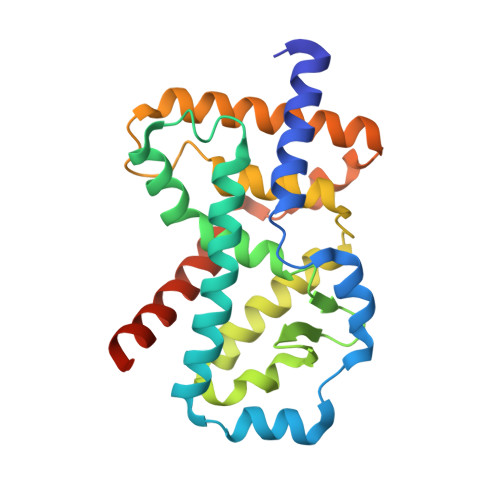Structure-Based and Property-Driven Optimization ofN-Aryl Imidazoles toward Potent and Selective Oral ROR gamma t Inhibitors.
Hoegenauer, K., Kallen, J., Jimenez-Nunez, E., Strang, R., Ertl, P., Cooke, N.G., Hintermann, S., Voegtle, M., Betschart, C., McKay, D.J.J., Wagner, J., Ottl, J., Beerli, C., Billich, A., Dawson, J., Kaupmann, K., Streiff, M., Gobeau, N., Harlfinger, S., Stringer, R., Guntermann, C.(2019) J Med Chem 62: 10816-10832
- PubMed: 31729873
- DOI: https://doi.org/10.1021/acs.jmedchem.9b01291
- Primary Citation of Related Structures:
6Q6M, 6Q6O, 6Q7A, 6Q7H - PubMed Abstract:
Retinoic acid receptor-related orphan receptor gamma-t (RORγt) is considered to be the master transcription factor for the development of Th17 cells that produce proinflammatory cytokines such as IL-17A. Overproportionate Th17 cell abundance is associated with the pathogenesis of many inflammatory conditions including psoriasis. In a high-throughput fluorescence resonance energy transfer (FRET) screen, we identified compound 1 as a hit with promising lipophilic efficiency (LipE). Using structure-based drug design based on a number of X-ray cocrystal structures, we morphed this hit class into potent imidazoles, exemplified by compound 3 . To improve the poor absorption, distribution, metabolism, and excretion (ADME) properties of neutral imidazoles, we extended our ligands with carboxylic acid substituents toward a polar, water-rich area of the protein. This highly lipophilicity-efficient modification ultimately led to the discovery of compound 14 , a potent and selective inhibitor of RORγt with good ADME properties and excellent in vivo pharmacokinetics. This compound showed good efficacy in an in vivo delayed-type hypersensitivity pharmacology model in rats.
Organizational Affiliation:
Global Discovery Chemistry , 181 Massachusetts Avenue , 02139 Cambridge , Massachusetts , United States.















